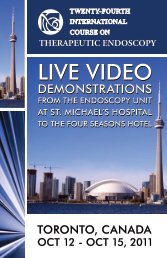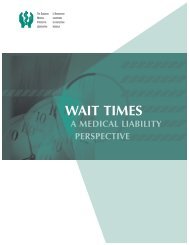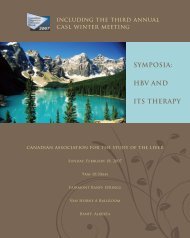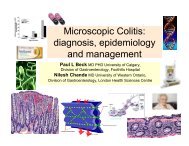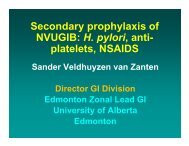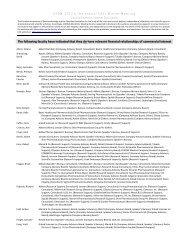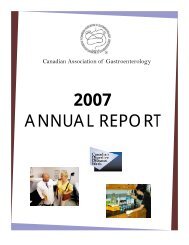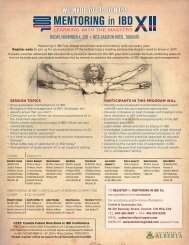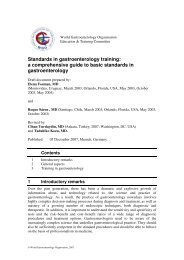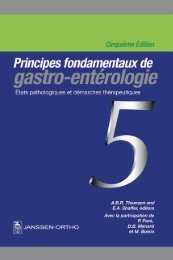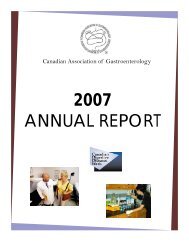Manifestations of Gastrointestinal Disease in the Child
Manifestations of Gastrointestinal Disease in the Child
Manifestations of Gastrointestinal Disease in the Child
Create successful ePaper yourself
Turn your PDF publications into a flip-book with our unique Google optimized e-Paper software.
<strong>Gastro<strong>in</strong>test<strong>in</strong>al</strong> <strong>Disease</strong> <strong>in</strong> <strong>the</strong> <strong>Child</strong> 731<br />
When biliary atresia is confirmed by <strong>the</strong> <strong>in</strong>traoperative cholangiogram, it<br />
should be followed by a surgical biliary dra<strong>in</strong>age procedure or so-called<br />
hepatoportoenterostomy operation (also known as a Kasai procedure). The<br />
atretic extrahepatic segment is dissected and a loop <strong>of</strong> bowel surgically<br />
attached to <strong>the</strong> area <strong>of</strong> <strong>the</strong> liver with <strong>the</strong> newly exposed biliary ductules. The<br />
age <strong>of</strong> <strong>the</strong> <strong>in</strong>fant at surgery is one <strong>of</strong> <strong>the</strong> critical factors predict<strong>in</strong>g successful<br />
dra<strong>in</strong>age after surgery. After 60-80 days <strong>of</strong> age <strong>the</strong> likelihood <strong>of</strong> success falls<br />
with time. Where <strong>the</strong> surgery is successful, with bile dra<strong>in</strong>age and clearance<br />
<strong>of</strong> jaundice, <strong>the</strong>re is long-term benefit although most children may eventually<br />
require liver transplantation.<br />
One <strong>of</strong> <strong>the</strong> major complications <strong>of</strong> biliary atresia after <strong>the</strong> Kasai operation<br />
is cholangitis (<strong>in</strong>fection <strong>of</strong> <strong>the</strong> biliary tree). This may present with <strong>in</strong>creas<strong>in</strong>g<br />
jaundice and elevated liver enzymes and should be treated aggressively with<br />
<strong>in</strong>travenous antibiotics.<br />
7.3.2.3 Alpha-1-antitryps<strong>in</strong> deficiency<br />
This is <strong>the</strong> most common <strong>in</strong>herited cause <strong>of</strong> neonatal cholestasis and can be<br />
associated with progressive liver disease. The homozygous deficiency state or<br />
Pi ZZ phenotype occurs <strong>in</strong> 1:2,000 live births. These patients have markedly<br />
reduced levels <strong>of</strong> alpha-1-antitryps<strong>in</strong>, which is <strong>the</strong> pr<strong>in</strong>cipal serum <strong>in</strong>hibitor <strong>of</strong><br />
proteolytic enzymes. Only 10-20% <strong>of</strong> all newborns with <strong>the</strong> ZZ mutation will<br />
develop neonatal cholestasis and <strong>the</strong> pathophysiology <strong>of</strong> <strong>the</strong> hepatic manifestations<br />
<strong>of</strong> this disorder is not fully understood.<br />
The presentation <strong>of</strong> alpha-1-antitryps<strong>in</strong> deficiency can be very similar to<br />
<strong>the</strong> presentation <strong>of</strong> biliary atresia. Hepatomegaly and acholic stools may be<br />
present and <strong>the</strong> liver biopsy may show proliferation <strong>of</strong> bile ducts. Intralobular<br />
bile duct paucity may be found at a later time. The accumulation <strong>of</strong> alpha-<br />
1-antitryps<strong>in</strong> prote<strong>in</strong> <strong>in</strong> <strong>the</strong> characteristic granules may not be evident <strong>in</strong> <strong>the</strong><br />
early biopsy. The outcome <strong>of</strong> this form <strong>of</strong> neonatal cholestasis is quite variable.<br />
Some <strong>in</strong>fants will develop early cirrhosis but <strong>in</strong> <strong>the</strong> majority <strong>of</strong> patients<br />
<strong>the</strong> jaundice clears with<strong>in</strong> <strong>the</strong> first four months <strong>of</strong> life.<br />
7.3.2.4 Alagille’s syndrome<br />
This is a form <strong>of</strong> familial <strong>in</strong>trahepatic cholestasis occurr<strong>in</strong>g <strong>in</strong> 1:100,000 live<br />
births. It results from mutations <strong>in</strong> <strong>the</strong> Jagged 1 gene which codes for a ligand<br />
for <strong>the</strong> notch <strong>in</strong>tracellular signal<strong>in</strong>g pathway. This pathway is <strong>in</strong>volved <strong>in</strong> <strong>the</strong><br />
regulation <strong>of</strong> cell differentiation and proliferation. Cholestasis results because<br />
<strong>of</strong> <strong>the</strong> progressive loss <strong>of</strong> bile ducts caus<strong>in</strong>g bile duct paucity. In <strong>the</strong> neonatal<br />
period <strong>the</strong> <strong>in</strong>fant may have acholic stools, but unlike biliary atresia, liver size<br />
is usually normal or only slightly enlarged. This is a multisystem disorder and<br />
<strong>the</strong> <strong>in</strong>fant with chronic cholestasis may have a number <strong>of</strong> o<strong>the</strong>r characteristic



